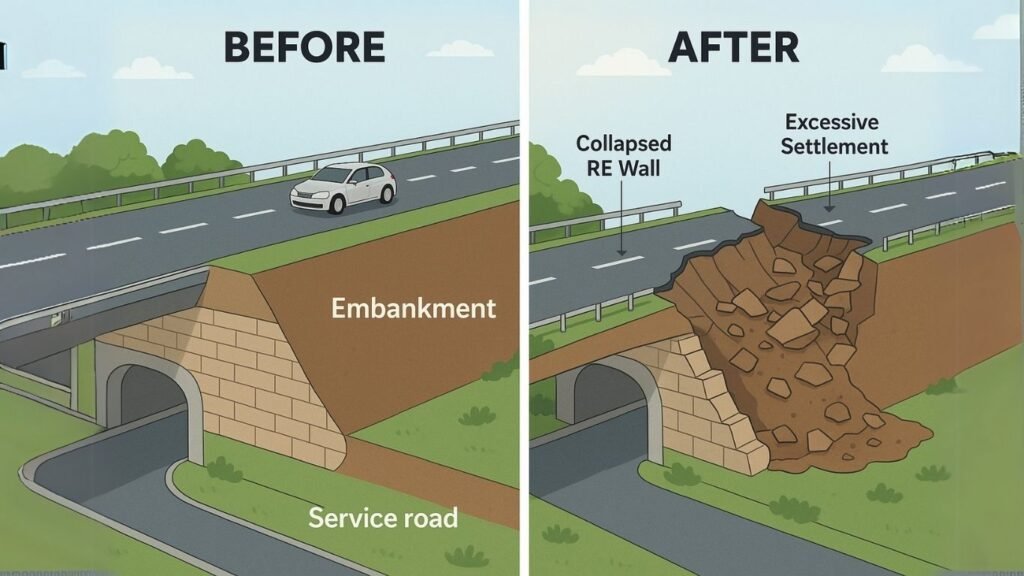The recent collapse of the National Highway 66 (NH-66) embankment in Kerala has triggered a major debate and urgent calls for reform in engineering practices – construction quality and project oversight in India’s infrastructure sector.
What Happened on NH-66 Near Kooriyad, Malappuram, Kerala?
On May 19, 2025, chaos erupted near Kooriyad in Malappuram district, Kerala, when a newly built section of the six-lane National Highway 66 (NH-66) suddenly collapsed at around 2:30 pm, trapping four vehicles and injuring at least seven people. The disaster struck just 600 meters from the Panampuzha bridge, on a stretch built over a reclaimed, waterlogged paddy field—an area notorious for its soft, unstable soil and proximity to both the Panampuzha and Kadalundipuzha rivers.
The collapse brought down the Reinforced Earth (RE) Wall and Embankment onto the service road & adjacent fields, splitting the paddy land and forming a small hill of debris. This shocking failure, which occurred mere days before the highway’s scheduled inauguration, has spotlighted deep flaws in construction quality, site assessment, and project oversight—problems echoed by similar cracks and subsidence reported in Kozhikode and Thrissur. In the immediate aftermath, the Ministry of Road Transport and Highways blacklisted the contractor KNR Constructions and the project consultant, while suspending key project officials and launching multiple investigations at both state and central levels.

The incident has not only triggered public protests and legal scrutiny but also forced a national conversation about the urgent need for scientific, site-specific engineering and stricter accountability in India’s infrastructure sector
Technical Analysis: Why Did the Collapse Occur?
1. Geotechnical and Structural Failures
- Foundation Soil Inadequacy: The embankment was constructed over a paddy field with soft, waterlogged soils. Experts concluded that the foundation soils could not bear the high embankment loads, leading to settlement and collapse.
- Negligence in Soil Testing: The concessionaire, KNR Constructions Ltd, failed to confirm ground conditions or improve soil bearing capacity before construction. This lack of due diligence was cited as a primary cause by both NHAI and the Ministry of Road Transport and Highways.
- Water Seepage and Drainage Issues: Water seepage played a significant role, as cracks and ground movement were exacerbated by poor drainage and obstruction of natural streams during construction.
2. Design and Methodology Flaws
- Unscientific Construction: The highway was elevated using gabion walls and soil fill rather than being built on pillars, despite repeated warnings from residents and local officials about the unsuitability of such methods for the area’s fragile, waterlogged terrain.
- Ignored Expert Warnings: The Geological Survey of India (GSI) had previously warned the National Highways Authority of India (NHAI) about the risks of landslides and slope instability along NH-66, stressing the need for site-specific engineering solutions and thorough soil investigations. These warnings, however, were not adequately addressed. A detailed report by The New Indian Express highlights how GSI had flagged faulty road work on NH-66 in Kerala.
3. Oversight and Accountability Lapses
- Consultant and Contractor Sanctions: Both KNR Constructions Ltd and the project’s independent engineering consultant have been barred from future NHAI projects. Key personnel were suspended, and remedial work is to be carried out at the contractor’s risk and cost.
- Lack of Responsive Action: Complaints from residents and warnings from local bodies were dismissed by both the construction company and NHAI, who pointed to their experience rather than addressing site-specific concerns.
Environmental and Community Impact
- Ecological Concerns: The construction obstructed natural watercourses, worsening waterlogging and destabilizing the ground. Soil from the project was dumped into nearby streams, further disrupting drainage and increasing the risk of collapse.
- Community Warnings Ignored: Residents and local leaders had repeatedly called for a pillar-supported structure, citing the region’s history of waterlogging and soft soils. Their concerns were overlooked, leading to a disaster that vindicated their warnings.
- Grassroots Action: In the absence of official intervention, locals spent their own resources to clear blocked streams, highlighting the lack of adequate environmental management by project authorities.
Legal and Regulatory Fallout
- Kerala High Court Intervention: The Kerala High Court has taken serious note of the incident, directing NHAI to submit a detailed report on the causes and proposed remedies. The court criticized the pace and quality of highway construction in the state, demanding scientifically sound remedial measures.
- Broader Scrutiny: The collapse has brought the role of state and central highway authorities under intense scrutiny, especially as similar structural issues have been reported on other stretches of NH-66.
Lessons and Recommendations
Key Takeaways
- Mandatory Geotechnical Investigations: All major infrastructure projects in sensitive areas must include comprehensive soil and groundwater studies.
- Adaptive, Site-Specific Design: Standardized solutions are inadequate for regions with complex geology; engineering must be tailored to local conditions.
- Robust Oversight and Community Engagement: Transparent quality control, independent audits, and genuine engagement with local stakeholders are essential.
- Environmental Safeguards: Projects should be planned to preserve natural drainage and minimize ecological disruption.
Regulatory Actions
- NHAI has initiated expert reviews and will implement new guidelines to prevent similar incidents in Kerala and elsewhere.
- Remedial work on the collapsed section will proceed under expert supervision, with costs recovered from the responsible contractor.
Conclusion
The NH-66 embankment collapse is a stark warning against complacency in engineering and project management. It demonstrates the catastrophic consequences of ignoring geotechnical realities, environmental factors, and community input. Going forward, infrastructure development in India must be grounded in scientific rigor, local context, and transparent accountability.




